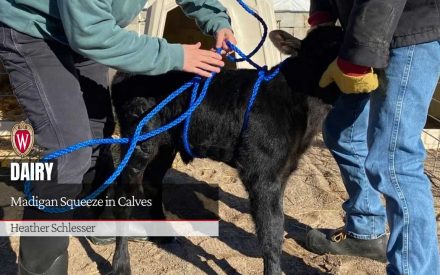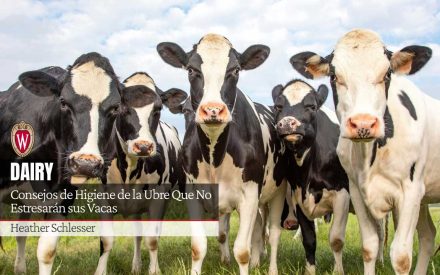What are NSAIDs?
Nonsteroidal anti-inflammatory drugs, or NSAIDs, are a class of drugs that inhibit the enzyme cyclooxygenase (COX), which causes a decrease in the amount of prostaglandin produced. Two primary forms of COX have been reported. COX-1 activity is mainly responsible for day-to-day physiological functions, such as maintaining gut and kidney function. COX-2 activity is generally induced under specific conditions, such as inflammation (Fitzpatrick et al., 2004; Vane & Botting, 1996). Therefore, inhibition of COX-2 is thought to account for most of the therapeutic effects of NSAIDs, while the inhibition of COX-1 likely accounts for most of the undesirable side effects such as gastrointestinal irritation, renal toxicity, and inhibition of blood clotting (Lees et al., 2004).
Why would we want to use NSAIDs?
The three–week period before and after calving is one of the most challenging times for dairy cattle because they must cope with physiological challenges such as decreased dry matter intake, impaired immune system function, and increased metabolic and systemic inflammation (Drackley, 1999; LeBlanc, 2010). After calving, inflammation has been documented in cattle (Bionaz et al., 2007; Huzzy et al., 2009). This suggests that cattle experience some degree of inflammation due to tissue damage associated with birthing and the immense metabolic demand associated with the onset of lactation (Bradford et al., 2015). Stress and inflammation related to calving can increase the incidence of diseases such as mastitis and clinical metritis (Gill, 2020). It is believed that using an NSAID will help to reduce the inflammation associated with calving and thus decrease the incidence of disease.
Do they work?
That answer depends on the NSAID you are using. Most NSAIDs available for animal use inhibit both COX enzymes with varying selectivity. This means the results vary depending on the NSAID you are giving. In this article, we will review the research findings of three NSAIDs, flunixin meglumine, meloxicam, and acetylsalicylic acid, for you to determine if they work.
Flunixin meglumine
Flunixin meglumine is currently the only FDA-approved NSAID for use in beef and dairy cattle and requires a prescription from your veterinarian. Flunixin meglumine (ex. Banamine ®) is approved to control fever due to bovine respiratory tract disease, mastitis, and the control of inflammation associated with endotoxemia (Smith et al., 2008). Flunixin meglumine is a COX-1 and COX-2 inhibitor but is more selective for COX-1 (Beretta et al., 2005).
Newby et al. (2016) looked into the efficacy of using flunixin meglumine to decrease inflammation and, thus, associated diseases after calving. In their study, they administered two treatments of flunixin meglumine (50 mg/ ml) intravenously. The first 72 animals enrolled in the study were randomly divided between the treatment group (n = 34) and the placebo group (n = 38). Treated animals received an injection of flunixin meglumine when they were moved into the calving pen immediately pre-calving and again 18 to 36 hours later during the morning lockup. Animals receiving the placebo treatment received an injection of saline when they were moved into the calving pen immediately pre-calving and again 18 to 36 hours later during the morning lockup. Shortly after beginning the study, it was determined that the animals treated so far with flunixin meglumine had an increased stillbirth rate. This outcome forced the researchers to change the study design. Therefore, the treatment protocol was modified, so the remaining animals enrolled in the study received an injection of flunixin meglumine about an hour after calving and a second injection about 24 hours after calving. Those animals receiving the placebo treatment received their first saline injection about an hour after calving and about 24 hours after calving.
Newby et al. found that animals treated with flunixin meglumine had greater odds of having a fever, which was generally associated with mastitis or metritis. 49% of the animals with a fever were in the mastitis or metritis group. Of the 51% of animals with a fever not in the mastitis or metritis groups, 48% had a fever within the first two days following calving. Flunixin meglumine also increased both the odds of retained placenta and the odds of metritis. The researchers also analyzed the milk production records of the 1,265 animals enrolled in the study for the first 14 days in milk and found that the flunixin meglumine-treated animals produced 1.6 kg/day less milk compared to the animals that received the placebo. Given these results and that flunixin meglumine administration before calving resulted in a five-fold increase in the number of stillborn calves, these researchers do not recommend using flunixin meglumine in cattle around the time of calving.
Meloxicam
Meloxicam has been approved for use in cattle in many European countries and Canada but not in the United States. However, if you have a valid veterinary client-patient relationship, Meloxicam can be prescribed by a licensed veterinarian for extra-label drug use in cattle. Meloxicam is known to be a preferential COX-2 inhibitor, thus targeting inflammatory processes rather than physiological functions (Newby et al., 2013, 2014). Swartz et al. (2018) were the first researchers to examine the effects of meloxicam administration pre- and post-calving. In their study, they gave 1 mg/ kg of meloxicam by mouth either 48 to 6 hours before calving or within 12 hours after calving. Those receiving meloxicam before calving also received a placebo within 12 hours after calving. The group of animals that received the bolus of meloxicam after calving also received a placebo bolus 48 to 6 hours before calving. The control animals received a placebo bolus both before and after calving.
These researchers found that treatment either before or after calving with meloxicam did not affect the incidence of retained placenta, metritis, or rectal temperature. However, these researchers saw an increase in milk production in those animals receiving meloxicam that did not have difficulty calving. Animals that received meloxicam before calving and did not have a hard birthing produced 4.3 kg/d more milk than the animals that had no issue calving and received meloxicam after calving. When meloxicam was administered before calving, there was no increase in the number of stillborn calves compared to controls. It is important to note that it is illegal to use extra-label drug usage to enhance animal performance (including milk production). Since there appears to be no therapeutic benefit of using meloxicam before or after calving, increased milk production would be the only benefit (Swartz et al., 2018).
Acetylsalicylic Acid
Acetylsalicylic acid (ex., Aspirin) is not approved by the FDA for use in lactating dairy cattle in the United States; dairy producers must consult with a licensed veterinarian before implementing treatments utilizing these products even though they are available over the counter. Use of these products without the consent of a licensed veterinarian is illegal. Acetylsalicylic acid is a weak inhibitor of both COX isoforms. Its beneficial effects are attributed to its ability to block the function of COX-2. Barragan et al. (2020) looked at the effects of treating cattle with acetylsalicylic acid after calving; cattle received 100 mg/ kg of acetylsalicylic acid in two boluses by mouth. Those animals in the treatment group received their first treatment in the maternity facility within 12 hours of delivery. Three additional treatments were provided at 12-hour intervals. Animals treated with the placebo were given gelatin capsules filled with water within 12 hours of calving and at three additional treatment times provided at 12-hour intervals.
These researchers found that a lower proportion of cows treated with acetylsalicylic acid developed clinical metritis at 7 ± 3 days in milk, and fewer tended to develop clinical endometritis at 50 ± 10 days in milk compared to untreated cows. These researchers also looked at milk production differences between treated and untreated animals. Overall, cows that received acetylsalicylic acid produced 1.82 kg/ day more milk than those receiving the placebo during the first 30 days in milk. When these researchers looked at the differences between the animals having calving difficulty (dystocia), they discovered that cows that had experienced dystocia and received acetylsalicylic acid produced 4.48 kg/ day more milk than cows with dystocia and did not receive acetylsalicylic acid. The effect of acetylsalicylic acid usage was not as pronounced in cows that had a normal calving indicating that treatment may be more beneficial for animals experiencing dystocia (Barragan et al., 2020). To date, no study has been conducted that provides acetylsalicylic acid before calving, so we do not know its effects on stillbirth.
Conclusions
Before using any of the discussed NSAIDs, it is essential to work with your veterinarian and determine the best protocol and drug for your farm. In addition, it is essential to note that all NSAID treatments have milk and meat withdrawal times that should be considered. Discarding milk when using these drugs is required to prevent the sale of milk contaminated by drug residues.
| Drug | Route of administration | Milk withdrawal (d) | Meat withdrawal (d) |
| Flunxixin meglumine | IV | 2 | 4 |
| Meloxicam | Oral | 5 | 21 |
| Meloxicam | IV or Sub-Q | 5 | 15 |
| Asprin | Oral | 1 | 1 |
Referneces
Barragan, A. A., L. Bauman, L. da Costa, J. Velez, J. D. Rozo Gonzalez, G. M. Schuenemann, B. Menichetti, J. Pineiro, S. Bas. 2020. Administration of acetylsalicylic acid after parturition in lactating dairy cows under certified organic management: part 1. Milk yield, milk components, activity patterns, fertility, and health. J. Dairy Sci. 103:113697-11712. https://doi.org/10.3168/jds.2020-18388.
Beretta, C., G. Garavaglia, and M. Cavalli. 2005. COX-1 and COX-2 inhibition in horse blood by phenylbutazone, flunixin, carprofen and meloxicam: An in vitro analysis. Pharmacol. Res. 52:302-306.
Bionaz, M., E. Trevisi, L. Calamari, F. Librandi, A. Ferrari, and G. Bertoni. 2007. Plasma paraoxonase, health, inflammatory conditions, and liver function in transition dairy cows. J. Dairy Sci. 90:1740 – 1750.
Bradford, B. J., K. Yuan, J. K. Farney, L. I. Mamedova, and A. J. Carpenter. (2015). Invited review: Inflammation during the transition to lactation: New adventures with an old flame. J. Dairy Sci. 98:6631-6650.
Drackley, J. K. (1999). Biology of dairy cows during the transition period: The final frontier? J. Dairy Sci. 82:2259-2273. https://doi.org/10.3168/jds.S0022-0302(99)75474-3.
Gill, C. (2020). Aspirin after calving can provide relief to dairy cows, increase milk production. Penn State News. Accessed July 7, 2022. https://www.psu.edu/news/reseearch/story/asprin-after-calving-can-provide-relief-dairy-cows-increase-milk-production/
Huzzy, J. M., T. F. Duffield, S. J. LeBlanc, D. M. Viera, D. M. Weary, & M. A. G. von Keyserlingk. (2009). Short communication: Haptoglobin as an early indicator of metritis. J. Dairy Sci. 92: pp. 621–625. https://doi.org/10.3168/jds.2008-1526.
Fitzpatrick, J. L., Nolan, A. M., Lees, P., May, S. A., (2004). Inflammation and Pain. In: Bovine Medicin. Second Ed. Blackwell Publishing, Oxford, UK, pp.1045–1066.
LeBlanc, S. J. (2010). Monitoring metabolic health of dairy cattle in the transition period. J. Reprod. Dev. 56(Suppl.): S29-S35. https://doi.org/10.1262/jrd.1056S29.
Lees, P., M.F. Landoni, J. Giraudel, and P.L. Toutain. 2004. Pharmacodynamics and pharmacokinetics of nonsteroidal anti-inflammatory drugs in species of veterinary interest. J. Vet. Pharmacol. Ther. 27:479-490.
Newby, N. C., D. L. Pearl, S. J. LeBanc, K. E. Leslie, M. A. G. von Keyserlingk, & T. F. Duffield. (2013). Effects of meloxicam on milk production, behavior, and feed intake in dairy cows following assisted calving. J. Dairy Sci. 96:3682-3688.
Newby, N. C., D. Renaud, R. Tremblay, & T. F. Duffield. (2014). Evaluation of the effects of treating dairy cows with meloxicam at calving on retained fetal membranes risk. Can. Vet. J. 55:1196-1199.
Newby, N.C., K. E. Leslie, H. D. Putnam Dingwell, D. F. Kelton, D. M. Weary, L. Neuder, S. T. Millman, T. F. Duffield. (2016). The effects of periparturient administration f flunixin meglumine on the health and production of dairy cattle. J. Dairy Sci. 100: pp. 582–587. https://doi.org/10.3168/jds.2016-11747
Smith, G. W., J. L. Davis, L. A. Tell, A. I. Webb, J. E. Riviere. 2008. Extralabel use of nonsteroidal anti-inflammatory drugs in cattle. Vet Med Today: FARAD Digest. JAVMA. 232: 697-701.
Swartz, T.H., H. H. Schramm, J. M. Bewley, C. M. Wood, K. E. Leslie., C. S. Petersson-Wolfe. 2018. Meloxicam administration either prior to or after parturition: Effects on behavior, health, and production in dairy cattle. J. Dairy Sci. 101: 10151-10167. https://doi.org/10.3168/jds.2018-14657.
Vane, J.R., and R.M. Botting. (1996). Mechanism of action of anti-inflammatory drugs. Scand. J. Rheumatol. Suppl. 102:9-21.
Download Article


 ▶️ Watch: Confort y diseño de instalaciones en granjas lecheras
▶️ Watch: Confort y diseño de instalaciones en granjas lecheras Madigan Squeeze in Calves
Madigan Squeeze in Calves Consejos de Higiene de la Ubre Que No Estresarán sus Vacas
Consejos de Higiene de la Ubre Que No Estresarán sus Vacas ▶️ Watch: Generalidades de la podología bovina especializada
▶️ Watch: Generalidades de la podología bovina especializada


